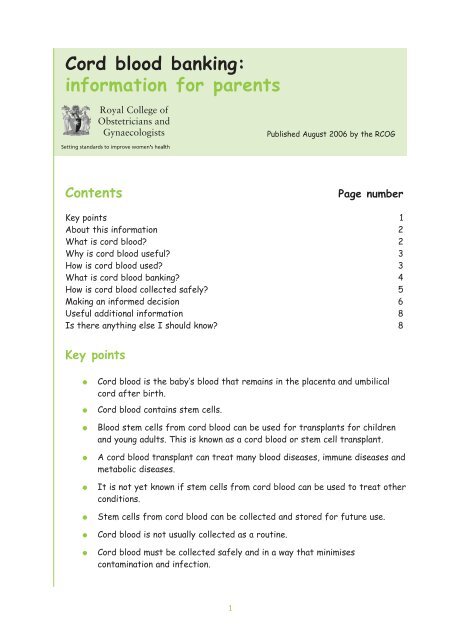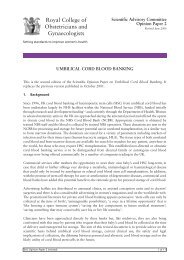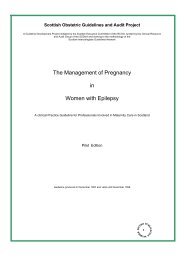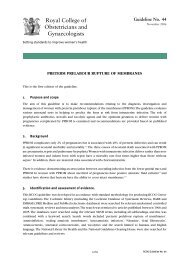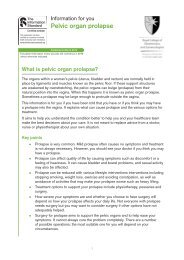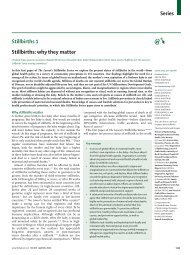Cord blood banking - information for parents
Cord blood banking - information for parents
Cord blood banking - information for parents
You also want an ePaper? Increase the reach of your titles
YUMPU automatically turns print PDFs into web optimized ePapers that Google loves.
<strong>Cord</strong> <strong>blood</strong> <strong>banking</strong>:<br />
<strong>in<strong>for</strong>mation</strong> <strong>for</strong> <strong>parents</strong><br />
Published August 2006 by the RCOG<br />
Contents<br />
Page number<br />
Key points 1<br />
About this <strong>in<strong>for</strong>mation</strong> 2<br />
What is cord <strong>blood</strong>? 2<br />
Why is cord <strong>blood</strong> useful? 3<br />
How is cord <strong>blood</strong> used? 3<br />
What is cord <strong>blood</strong> <strong>banking</strong>? 4<br />
How is cord <strong>blood</strong> collected safely? 5<br />
Making an in<strong>for</strong>med decision 6<br />
Useful additional <strong>in<strong>for</strong>mation</strong> 8<br />
Is there anything else I should know? 8<br />
Key points<br />
●<br />
●<br />
●<br />
●<br />
●<br />
●<br />
●<br />
●<br />
<strong>Cord</strong> <strong>blood</strong> is the baby’s <strong>blood</strong> that remains in the placenta and umbilical<br />
cord after birth.<br />
<strong>Cord</strong> <strong>blood</strong> contains stem cells.<br />
Blood stem cells from cord <strong>blood</strong> can be used <strong>for</strong> transplants <strong>for</strong> children<br />
and young adults. This is known as a cord <strong>blood</strong> or stem cell transplant.<br />
A cord <strong>blood</strong> transplant can treat many <strong>blood</strong> diseases, immune diseases and<br />
metabolic diseases.<br />
It is not yet known if stem cells from cord <strong>blood</strong> can be used to treat other<br />
conditions.<br />
Stem cells from cord <strong>blood</strong> can be collected and stored <strong>for</strong> future use.<br />
<strong>Cord</strong> <strong>blood</strong> is not usually collected as a routine.<br />
<strong>Cord</strong> <strong>blood</strong> must be collected safely and in a way that minimises<br />
contamination and infection.<br />
1
●<br />
●<br />
●<br />
●<br />
●<br />
●<br />
●<br />
●<br />
It is best if a trained technician who is not involved in the care of a woman or<br />
her baby collects cord <strong>blood</strong>.<br />
There are two types of cord <strong>blood</strong> bank:<br />
(a) private (commercial) banks<br />
(b) public banks.<br />
Private banks are generally <strong>for</strong>-profit organisations which store cord <strong>blood</strong> <strong>for</strong><br />
possible future use by an individual’s own family <strong>for</strong> a fee.<br />
Each hospital should have its own policy on private <strong>banking</strong> and make this<br />
policy available to prospective <strong>parents</strong>.<br />
A public bank, such as the NHS cord <strong>blood</strong> bank, stores donated cord <strong>blood</strong><br />
<strong>for</strong> use by patients anywhere in the world who need a transplant.<br />
A public bank may also store cord <strong>blood</strong> <strong>for</strong> families with a known genetic or<br />
other disease.<br />
The Royal College of Obstetricians and Gynaecologists (RCOG) supports public<br />
<strong>banking</strong> and donation to the NHS cord <strong>blood</strong> bank.<br />
The RCOG remains unconvinced about the benefit of storing cord <strong>blood</strong> with a<br />
private bank <strong>for</strong> families who have no known medical reason to do so.<br />
About this <strong>in<strong>for</strong>mation</strong><br />
This <strong>in<strong>for</strong>mation</strong> is <strong>for</strong> you if you are deciding whether to use a private (commercial)<br />
cord <strong>blood</strong> bank. It is based on the Royal College of Obstetricians and Gynaecologists<br />
(RCOG) Scientific Advisory Committee (SAC) Opinion Paper on Umbilical <strong>Cord</strong> Blood<br />
Banking published in 2006 (www.rcog.org.uk/index.asp?PageID=545). This Statement<br />
is due <strong>for</strong> revision in 2008.<br />
This <strong>in<strong>for</strong>mation</strong> aims to help you and your healthcare team make the best decisions<br />
<strong>for</strong> you and your family. It is not meant to replace specific advice from a doctor or<br />
midwife about your own individual situation.<br />
Some of the <strong>in<strong>for</strong>mation</strong> here may not apply to you. Your doctor, midwife, or another<br />
member of your healthcare team will discuss any further issues with you.<br />
What is cord <strong>blood</strong>?<br />
<strong>Cord</strong> <strong>blood</strong> is the baby’s <strong>blood</strong> that remains in the placenta and cord after birth.<br />
After the baby is born, the <strong>blood</strong> in the placenta and cord is no longer needed and is<br />
usually disposed of carefully.<br />
2
<strong>Cord</strong> <strong>blood</strong> contains many different types of cells including very small numbers of a<br />
particular type of cell, known as stem cells. These cells are the building blocks of all<br />
the other cells in the body. Different parts of the body are made up of different<br />
types of cells: the heart is made up of heart cells, the liver is made up of liver cells,<br />
<strong>blood</strong> is made up of <strong>blood</strong> cells, and so on. Stem cells can grow into these different<br />
kinds of cells in the body.<br />
Why is cord <strong>blood</strong> useful?<br />
<strong>Cord</strong> <strong>blood</strong> is currently used in the treatment of:<br />
●<br />
●<br />
<strong>blood</strong> related disorders, such as leukaemia, sickle cell anaemia and<br />
thalassaemia (also known as haemoglobinopathies)<br />
some immune system disorders<br />
●<br />
metabolic storage disorders, such as Hurler syndrome (an inherited condition<br />
caused by an enzyme deficiency).<br />
Some scientists have claimed that cord <strong>blood</strong> could potentially be used to cure<br />
diseases such as Alzheimer’s disease, Parkinson’s disease and conditions such as<br />
diabetes. They also claim that cord <strong>blood</strong> could be used to treat diseases affecting<br />
the brain, heart and spine.<br />
Other scientists argue that there is not enough evidence to back up these claims. It<br />
may be that in the future more diseases will be treated with cord <strong>blood</strong>. At present,<br />
however, much more research is needed.<br />
How is cord <strong>blood</strong> used?<br />
Blood stem cells are stem cells that grow into new <strong>blood</strong>.<br />
A cord <strong>blood</strong> transplant uses <strong>blood</strong> stem cells to replace diseased cells with healthy<br />
new cells and rebuild an individual’s <strong>blood</strong> and immune system. For the transplant to be<br />
a success, the new cells must match the individual’s own cells as closely as possible.<br />
There have been over 6000 successful cord <strong>blood</strong> transplants (between relatives and<br />
non-relatives) worldwide.<br />
<strong>Cord</strong> <strong>blood</strong> transplants can be used as an alternative to bone marrow transplants to<br />
treat some disorders. This has mainly been successful in treating young patients <strong>for</strong><br />
leukaemia.<br />
3
The advantages of a cord <strong>blood</strong> transplant, compared with a bone marrow transplant,<br />
are that:<br />
●<br />
●<br />
there are fewer complications with a cord <strong>blood</strong> transplant.<br />
it is easier to find a match from stem cells than from bone marrow. This, in<br />
turn, leads to increased access to transplantation, particularly <strong>for</strong> patients<br />
from ethnic minorities.<br />
●<br />
●<br />
cord <strong>blood</strong> can be frozen and stored <strong>for</strong> years so it is more readily available.<br />
there are fewer delays with a cord <strong>blood</strong> transplant. Delays are inevitable in<br />
the case of bone marrow transplants because of the need to search registers,<br />
contact would-be donors and the bone marrow retrieval procedure itself.<br />
The disadvantages are that:<br />
●<br />
●<br />
a cord <strong>blood</strong> transplant may not be possible. There may not be enough cells<br />
from one cord <strong>for</strong> a transplant, especially to an adult.<br />
<strong>for</strong> some <strong>blood</strong> conditions, such as certain leukaemias, a transplant using a<br />
child’s own <strong>blood</strong> may be harmful. This is because the stored stem cells may<br />
contain the same abnormality and risks that caused the child to become ill in<br />
the first place. In this case, a donation from another source would be better.<br />
What is cord <strong>blood</strong> <strong>banking</strong>?<br />
<strong>Cord</strong> <strong>blood</strong> <strong>banking</strong> is when cord <strong>blood</strong> is collected and stored <strong>for</strong> treating a disease<br />
or illness.<br />
Types of cord <strong>blood</strong> bank<br />
Public banks<br />
If you give birth in one of three hospitals in the south east of England, you can donate<br />
cord <strong>blood</strong> to a public bank, such as the NHS cord <strong>blood</strong> bank. There is also a small<br />
NHS public bank in Belfast in Northern Ireland (see section Is there anything else I<br />
should know?). Donation is voluntary and collection and storage is free of charge. A<br />
public bank stores cord <strong>blood</strong> <strong>for</strong> use by anyone anywhere in the world, thus ensuring<br />
fair access <strong>for</strong> all patients requiring stem cell transplantation. It is an alternative to a<br />
volunteer bone marrow donor registry.<br />
The RCOG supports public <strong>banking</strong> and donation to the NHS cord <strong>blood</strong> bank.<br />
If there is a known genetic condition in your family or you already have a child with<br />
leukaemia or <strong>blood</strong> related disorder, your clinician may recommend that you consider<br />
<strong>banking</strong> your baby’s cord <strong>blood</strong>. Your clinician may be able to arrange <strong>for</strong> cord <strong>blood</strong> to<br />
be collected and stored in the NHS cord <strong>blood</strong> bank <strong>for</strong> future use by your family. You<br />
should also discuss this with the doctor looking after the person in your family who is ill.<br />
4
Private (commercial) banks<br />
People can store cord <strong>blood</strong> with a private bank in the hope that, in the future, cord<br />
stem cells may be useful, should a member of their own family develop a disease<br />
treatable by stem cell therapy.<br />
The chances of your child ever needing to use his or her own cord <strong>blood</strong> are extremely<br />
small, so there is no guarantee that the cord <strong>blood</strong> will ever be needed. Nevertheless,<br />
you may feel this is worthwhile, like an insurance policy.<br />
There is a fee <strong>for</strong> collection and long-term storage of up to £1,500. Depending on<br />
circumstances, some private banks may store cord <strong>blood</strong> free of charge <strong>for</strong> certain<br />
families where there is a known genetic condition.<br />
If you have not banked with a private bank and your child develops a <strong>blood</strong> related<br />
disorder, immune system disorder or metabolic storage disorder in the future, then<br />
you still have other options. These are:<br />
●<br />
●<br />
cord <strong>blood</strong> from a public bank in the UK or internationally.<br />
use of other sources of therapy such as bone marrow transplants. There is<br />
worldwide collaboration with international bone marrow registries to find<br />
suitable matches <strong>for</strong> patients who require a bone marrow transplant.<br />
●<br />
treatment from a sibling who matches a family member who can give bone<br />
marrow.<br />
Full written <strong>in<strong>for</strong>mation</strong> on the private <strong>banking</strong> policy at your hospital should be given<br />
to you at your antenatal booking appointment. This <strong>in<strong>for</strong>mation</strong> may not be given<br />
routinely, so you may need to ask if you would like to find out more.<br />
The RCOG remains unconvinced about the benefit of storing cord <strong>blood</strong> with a private<br />
bank <strong>for</strong> families who have no known medical reason to do so.<br />
How is cord <strong>blood</strong> collected safely?<br />
<strong>Cord</strong> <strong>blood</strong> must be collected safely. It is important that:<br />
●<br />
●<br />
a trained technician who is not involved in your or your baby’s care collects the<br />
cord <strong>blood</strong>. It is important that neither your obstetrician nor your midwife<br />
should be distracted from looking after you and your baby during and<br />
immediately after childbirth.<br />
there should be no alteration in your ‘usual management’ of labour, such as the<br />
delivery of the placenta or clamping of the cord. Some evidence indicates that<br />
immediate cord clamping may be harmful to babies. However, delaying cord<br />
clamping can prevent a successful cord <strong>blood</strong> collection.<br />
●<br />
cord <strong>blood</strong> should be collected after the placenta has been delivered in a clean<br />
5
environment using methods and facilities, which meet the required regulations<br />
including the EU Tissue and Cells Directive.<br />
<strong>Cord</strong> <strong>blood</strong> collection may not be advisable or possible if:<br />
●<br />
●<br />
the baby is premature<br />
you have a multiple pregnancy<br />
●<br />
●<br />
●<br />
●<br />
the cord around the neck needs to be cut early to deliver the baby<br />
you are delivered by emergency caesarean section<br />
you are being prescribed certain medication<br />
you or the father of the baby have tested positive <strong>for</strong> a transmissible<br />
infection(s).<br />
Making an in<strong>for</strong>med decision<br />
If you are considering private <strong>banking</strong> you should discuss this with your doctor or<br />
midwife. You may wish to consider the following points:<br />
●<br />
●<br />
●<br />
●<br />
●<br />
Not all hospitals allow collection by private banks. You should ask about the<br />
private <strong>banking</strong> policy at your hospital during your antenatal booking<br />
appointment. Once you have made a decision about <strong>banking</strong>, you should let your<br />
doctor or midwife know.<br />
You may find that your midwife or obstetrician has been advised by their<br />
professional organisation not to collect <strong>blood</strong> <strong>for</strong> a private bank.<br />
There are a number of uncertainties surrounding cord <strong>blood</strong> storage. For<br />
instance, who owns the cord <strong>blood</strong> legally? What are your rights if the facility<br />
storing the cord <strong>blood</strong> breaks down and the cord <strong>blood</strong> becomes unusable?<br />
Private banks are run by private companies. If you decide to bank through a<br />
private company, you will enter into a contract between yourself and the<br />
company. It is your responsibility to check that you are happy with all the<br />
terms and conditions of the contract. Some private companies make additional<br />
charges to screen <strong>for</strong> bacterial diseases.<br />
Since April 2006, all UK cord <strong>blood</strong> banks come under the EU Directive on<br />
Tissue Cells 2004/23/EC and are required to be licensed by the Human Tissue<br />
Authority (HTA). <strong>Cord</strong> <strong>blood</strong> should be collected and banked in accordance<br />
with this. If you choose to use a private bank, it is your responsibility to<br />
check that the private bank is approved and follows correct procedures.<br />
6
Some questions to ask are as follows:<br />
Is the bank accredited/licensed <strong>for</strong> storage of cord <strong>blood</strong>?<br />
If it is a UK bank, has it been licensed by the Human Tissue Authority<br />
(HTA)?<br />
Does the bank follow proper collection procedures?<br />
What happens if no stem cells are collected?<br />
Does the bank follow best practice testing regimens?<br />
Does the bank follow best practice sample storage?<br />
Where is the cord <strong>blood</strong> stored?<br />
Is the transportation to the storage facility checked to ensure the <strong>blood</strong> is<br />
kept appropriately?<br />
When is the stored cord <strong>blood</strong> no longer useful?<br />
What happens to the cord <strong>blood</strong> when it is no longer needed?<br />
Who is responsible <strong>for</strong> screening the <strong>blood</strong> to ensure that HIV/hepatitispositive<br />
cord <strong>blood</strong> is stored separately?<br />
Could my child or any of my children use the cord <strong>blood</strong>, if I am not around?<br />
What will happen to my cord <strong>blood</strong>, if the bank is no longer functioning in<br />
the future?<br />
7
Useful additional <strong>in<strong>for</strong>mation</strong><br />
A Parent’s Guide to <strong>Cord</strong> Blood Banks<br />
www.<strong>parents</strong>guidecord<strong>blood</strong>.com<br />
The Society of Obstetrician and Gynaecologists of Canada patient <strong>in<strong>for</strong>mation</strong> leaflet<br />
www.sogc.org/health/pdf/cord-<strong>blood</strong>final_e.pdf<br />
The Anthony Nolan Trust is a charity that recruits and registers bone marrow donors<br />
www.anthonynolan.org.uk/<br />
Is there anything else I should know?<br />
●<br />
●<br />
The commercial company advertising itself as the UK <strong>Cord</strong> Blood Bank<br />
http://cord<strong>blood</strong>bank.com/uk/about.php is not the same as the NHS <strong>Cord</strong><br />
Blood Bank.<br />
The hospitals that routinely collect cord <strong>blood</strong> <strong>for</strong> storage in a public bank are<br />
Northwick Park Hospital in Middlesex, Barnet Hospital in Hert<strong>for</strong>dshire, the<br />
Luton and Dunstable Hospital NHS Trust in Luton and the Mater Hospital<br />
Trust in Belfast<br />
The RCOG consents to the reproduction of this document providing full acknowledgement is made. The<br />
text of this publication may accordingly be used <strong>for</strong> printing with additional local <strong>in<strong>for</strong>mation</strong> or as the<br />
basis <strong>for</strong> audio versions or <strong>for</strong> translations into other languages. In<strong>for</strong>mation relating to clinical<br />
recommendations must not be changed.<br />
© Royal College of Obstetricians and Gynaecologists 2006<br />
8


